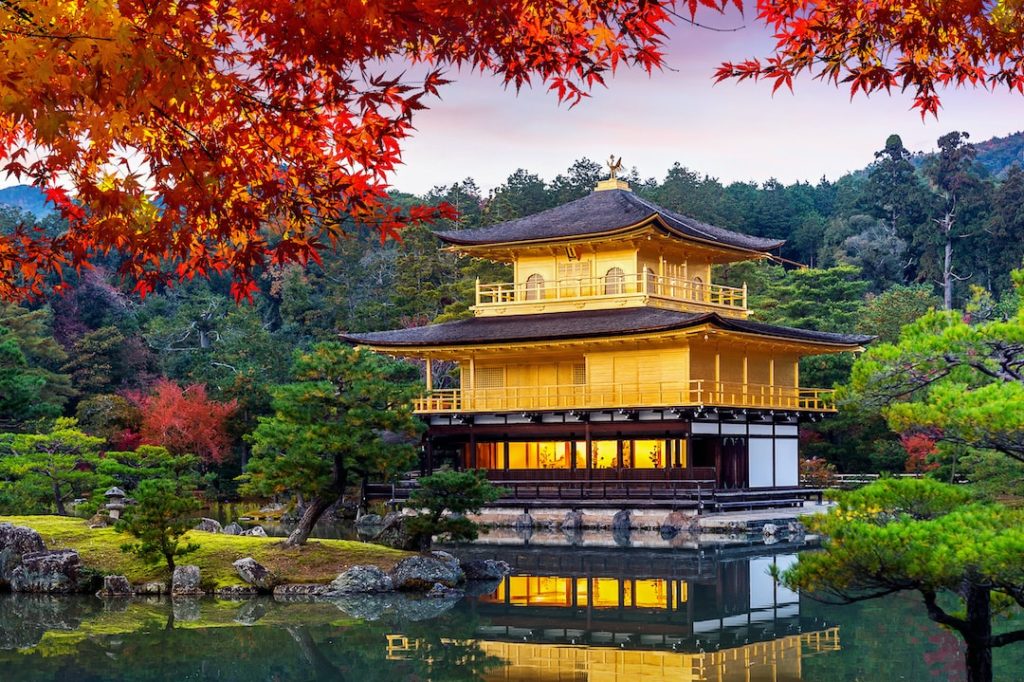
Kyoto is one of the fascinating cities in Japan. It has an ancient history that goes back as far as 1500 years, and it’s home to many notable attractions worth seeing.
Kyoto is a beautiful place to visit in Japan with its old temples and gardens, but there are also some more modern sites like Nijo Castle, which visitors will find interesting.
This unique region is known for its architecture and is home to many religions, including Shintoism, Buddhism, and Jodo-Shinshu Buddhism.
Kyoto is divided into five historical districts that you must not miss seeing during your visit to Japan.
1) Kita (northern Kyoto)
2) Kamigyo (suburbs north of the city)
3) Sakyo (east of downtown)
4) Higashiyama (Insight Guide recommends Fushimi Inari Shrine, Kiyomizu Temple, and Sanjusangendo as the three top attractions in this district. Other notable places include Ginkakuji Temple, Shoren-in Temple, Tenryuji Temple, and Heian Jingu Shrine.)
5) Minami (southern Kyoto/Arashiyama).
Although you could easily spend a week in Kyoto and still not see everything it has to offer.
Here is a list of 11 top hidden gems in Kyoto, just waiting for you to discover them.
1) Kinkakuji (Golden Pavilion)
Kinkakuji (literally “Temple of the Golden Pavilion”) is a Zen Buddhist temple.
Kinkakuji was initially constructed in 1397 to serve as the retirement villa for Shogun Ashikaga Yoshimitsu. The pavilion’s original gold leaf covering was said to have concealed an inner structure of silver and copper; however, this was lost because of fires.
The current pavilion has been completely covered with gold leaf on its exterior since 1955. It became part of the Historic Monuments of Ancient Kyoto UNESCO World Heritage Site under Japanese Imperial patronage.
The other attraction at Kinkakuji is its spectacular gardens, which are home to some 1200 cherry trees. These include around 400 cherry trees that are over 100 years old.
2) Nijō Castle
Tokugawa Ieyasu built Nijo Castle in 1603 for his son, heir, and future shogun Tokugawa Tadanaga after he married ten concubines.
This castle is surrounded by an exquisite garden known for its mossy paths, cherry blossoms in spring, maple trees in fall, and irises in summer.
Visitors can enjoy the spectacle of various flowers blooming throughout the seasons here at Nijo Castle.
3) Heian Jingu Shrine
Heian Jingu Shrine is a Shinto shrine built to commemorate the 1100th anniversary of the founding of Kyoto. It was opened in 1895 on family land donated by Emperor Showa, who started construction after his father, Emperor Meiji, passed away.
This beautiful shrine has several unique buildings that are all worth seeing during your visit, including Shiomizu-mon Gate, Taikoden Hall, Honden Main Sanctuary, Haiden Hall, and Kotoeri Room.
Visitors are also welcome to take part in events throughout the year, such as Hanatoro illumination from April 29th to May 7th.
4) Ginkakuji (Silver Pavilion)
Ginkakuji is a Zen Buddhist temple built in 1482 and stood atop a gorgeous hill surrounded by an attractive garden. This building has been covered with silver foil since Toyotomi Hideyoshi, who added the silver to protect it from fire damage.
The other attraction at Ginkakuji is its beautiful Japanese landscape garden, where visitors can enjoy walking through the pathways surrounded by tall trees and Sakura cherry blossoms (during spring).
5) Shoren-in Temple
Shoren-in Temple is one of Kyoto’s hidden gems.
It’s not as well known as some other temples in the city, but it has a lot to offer for those willing to take the time to find it.
Shoren-in was built in 1634 by Buddhist monk Houn Myozen who also founded Rinzai Zen Buddhism.
The temple grounds are relatively small. Its gate is at the top of a short flight of stairs from an alleyway between two shops: one selling religious paraphernalia and another offering taiyaki (fish-shaped pancakes) made on site.
About ten steps up to the main hall, boasting beautiful carvings by artisan Kokei Goriu lived during Japan’s Meiji Period.
These days, Shoren-in is still a working Buddhist temple and welcomes visitors from all backgrounds to come to pray for good luck, health, and other needs.
Visitors are encouraged to walk around the gardens surrounding the temple or even rest in one of its small tea rooms.
The leaves from nearby trees also add something special to the serene atmosphere inside the main building, where a statue of Buddha sits before a beautiful wall painting of a Japanese mountain scene.
Shoren-in Temple is genuinely one of Kyoto’s best-kept secrets and should not be missed by anyone traveling through Japan’s former capital city.
6) Kiyomizudera Temple
Kiyomizudera Temple was built in 780 and stood at the base of Higashiyama hill behind a large waterfall where visitors can take part in purifying ceremonies called “o-fuda sai” held several times per day by Buddhist monks.
One of the top attractions at Kiyomizudera Temple is its picturesque wooden stage that juts out over 100 feet (30 meters) above ground level.
On this stage, there is a tall pillar with a metal ball on top called “suzuri-bashira,” which is said to have been used by Kannon, the Buddhist goddess of mercy.
The temple itself has long been a critical destination for Japanese people praying for good luck, health, and other needs, as seven other temples in Japan bear its name.
The privately run building next to the main hall offers a look at some “o-mikuji” slips available to let visitors pick their fortunes from those hanging inside.
Every year on March 18th and October 18th, unique festivals are held that include dancing. In these celebrations, daruma dolls, which resemble a cross between a teddy bear and a monk, are given as presents.
8) Kitano Tenman-gu Shrine
This famous shrine is said to have been founded by Fujiwara no Kamatari, who was one of the most influential figures in Japan’s Nara Period.
Because of his leadership role at this shrine, he is known as Tenjin-sama.
At this shrine, many objects on display range from old Buddhist scrolls written for priests for prayer to an extremely rare four-footed tortoise that legend says brings good luck.
Over 100 stones around the outside walls of Kitano Tenmangu Shrine were placed by the people who visited the temple during its early days and now act as wish-granting objects where people can hang up their prayers.
There is a small pond at the entrance with a hand-operated water pump that visitors can use to fill up a cup with the special water that the shrine has become known for.
A walk around this area is said to bring good luck and health and serve as an opportunity to leave behind worldly distractions—including stress from work—and enjoy life in its simplest form.
Kitano Tenmangu Shrine is truly one of Kyoto’s hidden gems!
11) Gioji Temple
Buddhist monk Kukai found Gioji Temple, born on Mt. Koya, and eventually went off to study at China’s Todaiji temple during the Nara Period (710–794).
You can find this temple in the Arashiyama district of Kyoto and stands near the top of a hill deep in the woods.
At Gioji Temple, visitors will find an exciting statue that shows Kukai riding on top of a white elephant while deep in thought.
However, the real reason for this statue is to commemorate the fact that the elephant had been given to Kukai by an Indian King as a symbol of his high status.
At Gioji Temple, there are many objects on display prized by Buddhist monks, including one of Japan’s three national treasures—the Cintamani Stone—and some other interesting items related to Kukai.
This temple is another excellent example of Kyoto’s rich cultural history and should not be missed by anyone visiting Japan.
Final Thoughts
Kyoto’s temples are well-worth exploring. They’re filled with fascinating objects, natural beauty, and stories that can be traced back hundreds of years.
The best thing about these hidden gems is the opportunity to explore a world apart from our fast-paced modern society—a place where you can experience peace and mindfulness amidst an unspoiled natural setting.…
